The enormous dinosaurs that once roamed our planet all died out about 66 million years ago. Fossils of these extraordinary animals are rare, as conditions that preserve them are highly specific. Recently, wealthy collectors who previously focused on high-value works of art have expanded into natural history—and are acquiring unique fossil skeletons for private collections. The remains of ancient creatures are an important part of our history; they are irreplaceable and their value for science is priceless.
The United States is the source of many of the dinosaurs sold. Laws allow the sale and export of fossils found on private lands, and dinosaur remains are in many western states, especially Montana, Wyoming, Utah, and Colorado. Fossils of vertebrates are scarce, and dinosaur skeletons are especially uncommon. Paleontologists estimate that only about 120 known specimens of individual Tyrannosaurus rex have been found worldwide, and at least half of them are privately owned and not available for study. The remaining individuals compose a tiny data set, especially of juvenile specimens, so learning the biology and evolutionary history of these extinct animals is severely constrained.
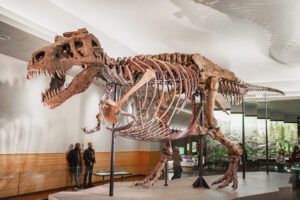
Sue the Tyrannosaurus rex in its new suite in the Evolving Planet exhibit hall at the Field Museum of Natural History, Chicago, Illinois (Wikipedia)
Sue, Stan, and Big John
One of the largest and best-preserved Tyrannosaurus rex specimens ever found has the nickname of Sue. Discovered in 1990 on the Cheyenne River Indian Reservation in South Dakota, the skeleton is named after paleontologist Sue Hendrickson, who originally found the bones. The dinosaur is about 90 percent complete, suggesting that soon after death, water and mud covered it. Sue is 40 feet (12 m) long, stood about 12 to 13 ft (3.6 to 3.9 m) at the hips, and is estimated to have weighed around 18,000 to as much as 30,000 lb (8,400 and 30,800 kg). The skull weighs about 600 lb (272 kg).
It took several years to resolve the ownership of Sue, but once completed, the Field Museum in Chicago attempted to purchase the skeleton. Instead, Sotheby’s put it up for auction in 1997. Fortunately, an unusual combination of donors, including the California State University System, Walt Disney Parks and Resorts, McDonald’s, Ronald McDonald House Charities, and various individuals banded together to purchase Sue for the Field Museum. At the auction, the Field Museum could make the highest bid and paid the final cost of $8.3 million (USD).
This remarkable price gave dinosaur skeletons new prestige. Many who pay attention to the “collectibles” market trace the current dino-ownership craze to the 1997 auction of Sue.
Stan, another T. rex, was discovered in South Dakota in 1987 and excavated in 1992. Named after the amateur paleontologist who initially discovered the bone fragments, Stan’s skull is nearly complete, and excavators found the bones in pristine condition. The fossils of this animal are about 70 percent complete. In the prime of life, Stan was approximately 38 ft (11.7 m) in length and about 12 ft (3.6 m) tall at the hip. Stan’s original weight is estimated to be around 16,875 pounds (7,650 kg)
Christie’s auction house sold Stan in 2020, for $31.8 million to an anonymous buyer. The skeleton disappeared for a few years, but then an announcement was made that Stan would be the centerpiece of a new museum that is under construction in Abu Dhabi.
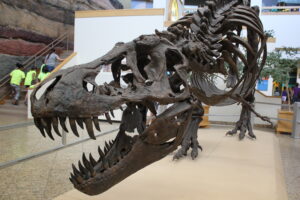
A cast of Stan the T. rex at the New Mexico Museum of Natural History (Wikimedia)
Big John, the skeleton of a fossilized Triceratops horridus, also hails from South Dakota. A professional fossil hunter found the skeleton on a private ranch in 2014, and it is nicknamed after the owner of the ranch. Possibly the largest known skeleton of a Triceratops, the animal was about 9.8 ft (3 m) in height and 26 ft (8 m) long from the tip of the snout to the end of the tail. Fossil remains include an 8 ft, 7 inch (2.62 m) skull and collar bone; the prominent two top horns are each over 3 ft (1 m) long.
An auction house in Paris sold the skeleton for $7.7 million (USD) in 2021 to a US-based entrepreneur who beat out 10 other bidders. The reconstructed Triceratops is currently loaned to the Glazer Children’s Museum in Tampa, Florida for a three-year public exhibition.
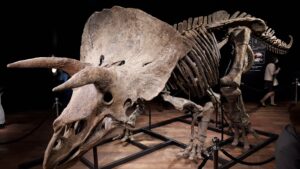
The Big John triceratops skeleton, on display at the Drouot auction house in Paris (Wikipedia)
These three dinosaurs, along with others that have been sold at auctions, were discovered in the sandstones and mudstones of the Hell Creek Formation. This body of rock is about 66 million years old, so originated at the end of the Cretaceous period and along the continental margin of the Western Interior Seaway that once divided North America. Sediments were deposited in river channels and deltas in flood-plain environments — ideal conditions for preserving fossils. Besides dinosaurs, many fossils of crocodiles, lizards, snakes, turtles, frogs, and other animals, plus plants and invertebrates, have been discovered in the formation. Today, rocks of the Hell Creek Formation extend across sizeable areas of Montana, North Dakota, South Dakota, and Wyoming.
Treasure Hunts
Ranchers who own private lands where rock formations might contain dinosaur remains used to allow paleontologists to search for and excavate fossils on their land for free. The researchers would properly handle any specimens discovered and they would be stored in public institutions where they could be studied.
With the potential for an important find bringing in a share of millions of dollars, however, increasingly owners now wait to give prospecting rights to the highest bidder—usually a commercial collector. These collectors focus on saleable specimens. Besides land destruction, a major concern with this type of fossil collecting is the loss of context data—exactly where the fossil was found in the rock record, so the evolutionary framework is known, as well as other fossils that were found in the same place.
When fossils go into auctions and are sold to the highest bidder, public museums and other institutions with tight budgets don’t have a chance. Once fossils disappear into private collections, we lose them to science.
This concern has received attention. The Society of Vertebrate Paleontology, an international association of professional and amateur vertebrate paleontologists, believes that scientifically important fossils should be held in perpetuity in the public trust, preferably in a research institution such as a museum where they can benefit the scientific community and future generations. Not surprisingly, commercial fossil dealers have strongly opposed any legislation that might restrict their profits.
Motivated by curiosity about our world, scientists are continuously advancing knowledge with new discoveries and techniques. Dinosaur fossils, especially those of nearly complete individuals, are extremely rare. Allowing these to be auctioned to high bidders and preventing scientific study is a tremendous loss of a heritage that belongs to everyone.
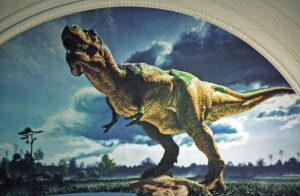
Painting of Sue the T. rex in the Field Museum of Natural History, Chicago, Illinois, by James St. John, 2010 (Wikimedia)
If you liked this post, please share it and/or leave a comment or question below and I will reply – thanks! And if you’d like to receive a message when I publish a new post, scroll down to the bottom of this page and leave your email address on my website. Join now to learn more about geology, geography, culture, and history.
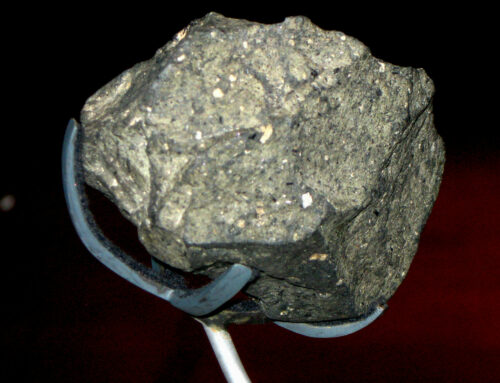
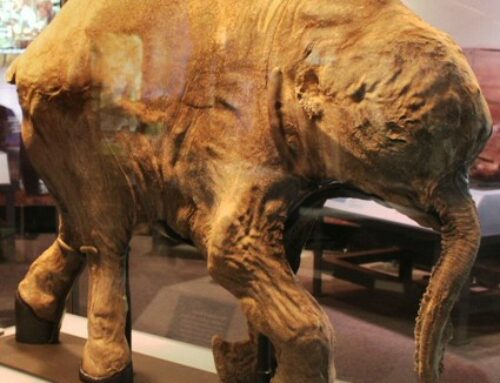

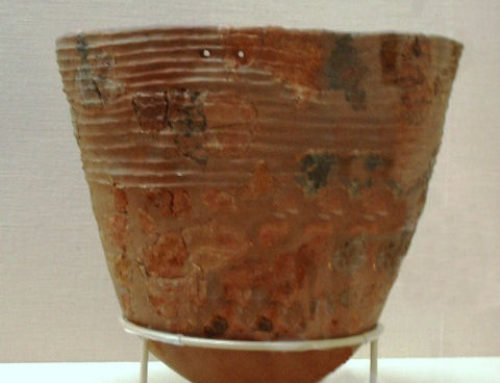
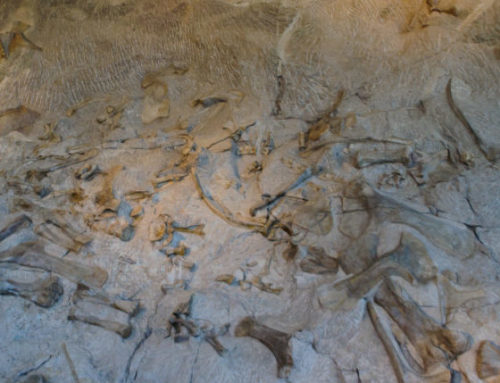
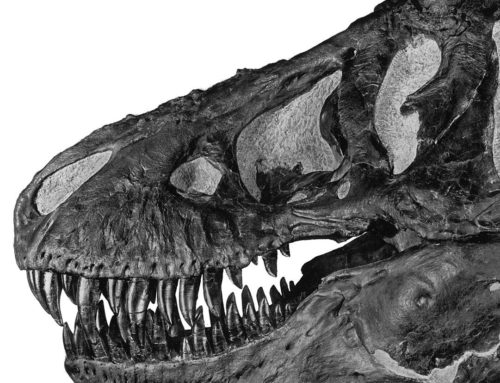
Canada, at least Alberta, has a different idea:
“Fossils can be collected in Alberta on Crown Land and on private land with the permission of the landowner. Surface collecting is allowed but not digging or excavation.
Fossils collected may be kept in a rock hound’s private collection and cannot be sold. It is illegal to sell any fossil found in Alberta without a disposition certificate. If the fossil is rare or may have some scientific value the person who found it is strongly encouraged to take a photograph and send the information to the Royal Tyrrell Museum, Drumheller, where it can be assessed. If the fossil is of no value to the Alberta Government for scientific or research purposes, a disposition certificate may be
issued if the fossil is eligible for disposition. http://www.afrc.ca/AFRC%20Doc%20Legal%20Fossils%202.pdf
Excellent – thank you for this information! Makes much more sense than the laws in the US. And of course, Alberta has lots of fossils. Visiting the Tyrell Museum is something I have wanted to do for decades — someday I hope it happens!
Any progress on the legal front? With those high auction prices, it is no surprise that landowners and treasure hunters are focused on the financial rewards. Even with legal barriers in place, I imagine we’d see a black market trade in fossils. But hopefully, at a much reduced level. And if you don’t donate your fossil skeleton to a museum, or put it on public display, what do you do with it? Use it as lawn sculpture? Place it in your mansion’s foyer? Impress your friends and family, and frighten the neighbor’s dog?
I am not aware of any laws on the horizon that would limit sales (previous attempts were unsuccessful). As for why a private collecter would want an enormous fossil skelton, unfortunately, I expect that showing it off to friends is a major driver. Thanks for the comment.